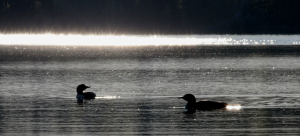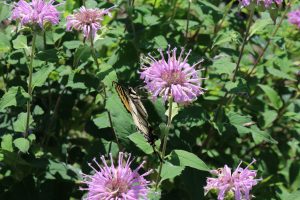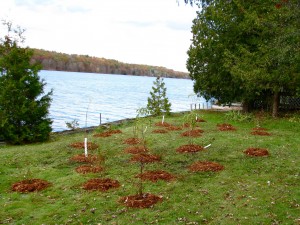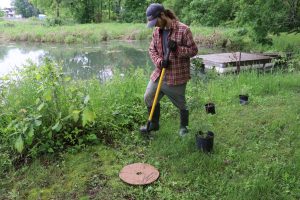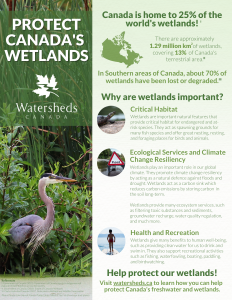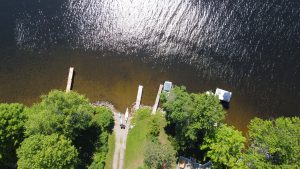by Robert Pye, Executive Director, Watersheds Canada Nature art fills my home, a growing collection that started before I even owned four walls to display it. Framed wildlife prints by the talents of Carl Brenders and Michael Dumas, for example, were acquired in my starting-out days of paying rent and student loans. Many years later though, I have property where my taste in art imitates the wildlife that surrounds my country home. My most cherished work of nature art is a one-of-a-kind ... Read More
Mother’s Day gifts that help Canada’s pollinators
Right now, shorelines across Canada are being restored with native species of plants which will help stabilize soils and prevent erosion, slow down and reduce overland runoff, and provide beautiful and valuable wildlife habitat. You can ensure this important work continues with a thoughtful Mother’s Day gift. Thanks to the talents of Ottawa nature artist Lynn Moore, you can now give a “bouquet” of native wildflowers for Mother’s Day! This bouquet of Wild Bergamot and Wild Columbine will have ... Read More
How to Soften a Shoreline Property
by Alana Coulombe, Education programs administrator As the interface between land and bodies of water, shorelines are essential for both humans and wildlife and must be protected against erosion and flooding. Historical means of shoreline protection consisted of hardened structures such as retaining walls made of concrete, steel, armour stone, gabion baskets, or wood. However, this shoreline armouring can have severe ecological and economic impacts with few short-term benefits. Recent studies ... Read More
How Native Plants Help with Erosion Control
by Jane Pangilinan, Digital Engagement Technician Erosion is a major problem for shorelines, agriculture, and freshwater areas. Erosion is a natural process that removes soil and also reduces specific aspects of the soil like its ability to retain water (Duran Zuazo & Rodriguez Pleguezuelo, 2008). Erosion affects the soil’s ability to grow food and can cause eroded land cover that can lead to severe land loss. Human impacts are known to accelerate erosion (Aziz & Islam, 2023) and ... Read More
This World Water Day, see the amazing fish habitat projects you have already helped complete!
This World Water Day, I want to introduce you to a place very special to me: Long Sault Creek. Because of individual donor support and local community groups, Long Sault Creek was transformed and restored. In total, 60 native tree species were planted, and as they grow, they will provide decades of shade along Long Sault Creek -- coldwater habitat for a naturally-reproducing population of brook trout. I went back to visit this creek last fall and was blown away by the growth of the native ... Read More
Giving Back to Your Freshwater: Using The Natural Edge to create a resilient and beautiful shoreline
by Monica Seidel, Communications and Fundraising Manager With summer just a few months away, you may find yourself already planning for upcoming adventures on the lake. Paddling, swimming, wildlife viewing, and fishing are some of the activities you may be looking forward to. Lakes provide many benefits to people: memory-building with family and friends, a connection to culture and traditions, or economic and recreation opportunities. And all of these benefits and activities depend on healthy ... Read More
Protecting Canada’s Water Quality with Native Plants: My Time at Watersheds Canada
by Chantal Lefevre, Natural Edge Regional Coordinator From a young age, I have spent my summers in lakes and rivers either boating, swimming, or just exploring the environment. My love for nature drove me to explore a career in the environmental field. I started my post secondary learning experience at Fleming College, attaining a diploma as an environmental technician and advanced diploma as an environmental technologist. My quench for knowledge was not satisfied, so I continued my formal ... Read More
Celebrate World Wetlands Day with these 4 Resilient Shorelines Resources!
by Nicole Dubé, Freshwater Health Coordinator Did you know Canada is home to 25% of the world's wetlands? In fact, there are approximately 1.29 million square kilometres of wetlands covering 13% of Canada's terrestrial area! Wetlands are important natural features that provide critical habitat for endangered and at-risk species. They act as spawning grounds for many fish species and offer great nesting, resting, and foraging places for birds and animals. They also play an important role in ... Read More
Continuing Momentum from Ontario’s Municipal Elections: One Year Later
by Darlene Coyle, Environmental Policy and Planning Lead In September, local candidates and voters in Ontario showed up at the polls to drive local change for their freshwater and shoreland health. Many people participated in Watersheds Canada's "Engaging Municipal Elected Officials to Protect our Freshwater" webinar. A year later, we want to look back at the priorities voters saw going into municipal election time and how we can help you bring important resources and programs to your ... Read More
10 Days of Winter Fun!
Each item in this series will help you and your family enjoy nature this winter as you get outside, help local species, try a new activity, and appreciate nature! All of the activities are low barrier and low cost to make them as inclusive as possible. Whether you are a seasoned winter explorer or new to Canadian winters, there are lots of small and fun ways to enjoy this season. Let's get started with Watersheds Canada’s 10 Days of Winter Fun! 1. Making Maple Taffy Maple taffy, or tire ... Read More
- « Previous Page
- 1
- …
- 7
- 8
- 9
- 10
- 11
- …
- 18
- Next Page »

